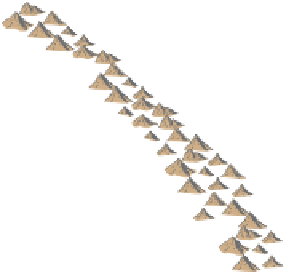Geology Reference
In-Depth Information
Uplands
Lowlands
P
aleo
eq
Land
Mountains
Phosphate deposits
Evaporites
Barrier reefs
Volcanoes
Epeiric sea
Deep ocean
Barrier
reefs
◗
Figure 20.20
Permian Paleogeography of North America
deposits characterized by thinly bedded black shales, graded
beds, coarse sandstones, graywackes, and associated vol-
canic material. This suite of sediments marks the onset of
mountain building, in this case, the Taconic orogeny. The
subduction of the Iapetus plate beneath Laurentia resulted
in volcanism and downwarping of the carbonate platform
(Figure 20.24b). Throughout the Appalachian mobile belt,
facies patterns, paleocurrents, and sedimentary structures
all indicate that these deposits were derived from the east,
where the Taconic Highlands and associated volcanoes were
rising.
The final piece of evidence for the Taconic orogeny
is the development of a large
clastic wedge
, an extensive
accumulation of mostly detrital sediments deposited adja-
cent to an uplifted area. These deposits are thickest and
coarsest nearest the highland area and become thinner and
finer grained away from the source area, eventually grad-
ing into the carbonate cratonic facies (
◗
Figure 20.25). The
clastic wedge resulting from the erosion of the Taconic High-
lands is referred to as the
Queenston Delta
. Careful map-
ping and correlation of these deposits indicate that more
than 600,000 km
3
of rock were eroded from the Taconic
Highlands. Based on this fi gure, geologists estimate that the
Taconic Highlands were at least 4000 m high.
The Taconic orogeny marked the first pulse of
mountain building in the Appalachian mobile belt and
was a response to the subduction taking place beneath
the east coast of Laurentia. As the Iapetus Ocean nar-
rowed and closed, another orogeny occurred in Europe
during the Silurian. The Caledonian orogeny was

























Search WWH ::

Custom Search